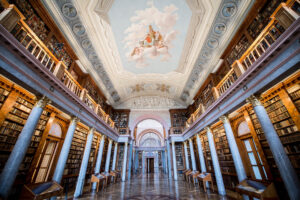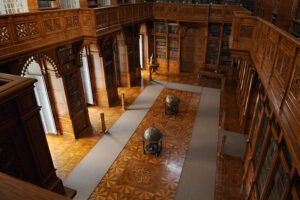- Home
- All Courses
- Contemporary library and information skills
Curriculum
- 9 Sections
- 31 Lessons
- 14 Weeks
- Introduction3
- 1) Library basicsThe main types of documents covered in these lessons, and the principles of the organisation and retrieval of library collections.2
- 2) Library use in the SZTE Klebelsberg Library and ArchivesThe chapter provides help on how to find and use the printed documents of the SZTE Klebelsberg Library and Archives, including the online options.5
- 3.1Video lesson: Library tour16 Minutes
- 3.2Video lesson: The website of the SZTE Klebelsberg Library and Archives9 Minutes
- 3.3Reading lesson: Printed documents in the SZTE Klebelsberg Library and Archives30 Minutes
- 3.4Reading lesson: Print periodicals30 Minutes
- 3.5Reading lesson: Encyclopedias and Lexicons – from glossaries to online forms30 Minutes
- 3) Search the Library 1: online catalogue(s)This chapter covers the basics of database searching. It introduces the online catalogue of the SZTE Klebelsberg Library and Archives (Qulto), gives useful tips on how to use it more efficiently, and explains what you need to know about interlibrary loan.4
- 4.1Reading lesson: Library catalogues and electronic databases: basic search information25 Minutes
- 4.2Video lesson: The online catalogue of the SZTE Klebelsberg Library and Archives: basics8 Minutes
- 4.3Video lesson: The online catalogue of the SZTE Klebelsberg Library and Archives: extra features with registration10 Minutes
- 4.4Reading lesson: Interlibrary Loan, Combined Library Catalogues, and Metasearch Engines25 Minutes
- 4) Search the Library 2: electronic resourcesThis chapter looks at searching the online resources provided by the SZTE Klebelsberg Library and Archives.6
- 5.1Reading lesson: Electronic resources in general20 Minutes
- 5.2Reading lesson: Electronic resources at the SZTE Klebelsberg Library and Archives25 Minutes
- 5.3Video lesson: Online resources – Summon Discovery8 Minutes
- 5.5Reading lesson: International databases15 Minutes
- 5.6Reading lesson: What to know about eBooks?30 Minutes
- 5.7Add-on: Google and others25 Minutes
- 5) Managing digital library content and community-based content developmentThis module presents repositories, the institutional digital collections specific to higher education libraries. In addition to a general introduction, special emphasis is given to SZTE Contenta, a repository system maintained by the SZTE Klebelsberg Library and Archives.4
- 6) Academic writingThis module provides an insight into the criteria, characteristics and techniques of academic writing, the skills involved in collecting and managing literature, and the principles of scholarly writing.3
- 7) Writing history and librariesThis module gives an overview of the types of scripts and documents from different periods and the different types of libraries.3
- Glossary of terms1
Reading lesson: Libraries
Having looked at the history of writing and documents in the previous lesson, in this lesson we will briefly review the history of libraries.
Libraries in different eras
In this section, we discuss the evolution of libraries – from their basic initial manifestations in antiquity (in as early as the 600s BC) through the great libraries of the Middle Ages to the modern institutions of today.
Early libraries in antiquity
Mesopotamia
In Mesopotamia, King Ashurbanipal (668–626 BC), who was one of the most literate rulers of the ancient world, established his own library in the city of Nineveh. Although the city was destroyed by hostile armies, some clay tablets were preserved over the centuries in the ground. In the mid-19th century, the ruins of the city were unearthed as part of an expedition and more than 60,000 clay tablets were found. A significant number of these were transported to London, where they were thoroughly analyzed. In addition to details of the history of ancient Mesopotamia being revealed, it was also discovered that some of the “documents” had also been reproduced, suggesting that there may have been many small local collections besides the large library.
Egypt
The largest library of antiquity was in Alexandria in the 3rd century BC, with a collection of more than half a million papyrus scrolls. The Library of Alexandria is known to have employed professional librarians who also created and used catalogues. Unfortunately, the collection was destroyed in a fire in 43 BC. To this day, this is considered an irreplaceable loss, since according to contemporary accounts, the grand library housed copies of almost every scholarly and literary work produced in the ancient world.
Rome
Known to have highly appreciated the written word themselves, the conquering Romans amassed a vast number of Papyrus scrolls from the Greeks. In addition, works by prominent Roman authors were published by actual publishing houses, which relied on slave labor to have scrolls copied. The Romans also perfected the way of keeping records of books by attaching a small bone tag to rolled-up scrolls to provide the kind of essential information about each scroll that the spines of books contain today.
Rome had a public library as early as 40 BC, and, according to historical records, 100 years before the fall of the Roman Empire, there were nearly thirty public libraries operating in the city.
The wealthier Romans maintained private libraries of varying sizes. The ash from the volcanic eruption that destroyed the city of Pompeii preserved a private Roman library at Herculaneum, and a shelved room containing hundreds of scrolls was found among the ruins excavated in the 18th century.
From the Middle Ages to the Modern era
The medieval history of libraries is connected to codices, the production and collection of which was originally limited to the Church.
- Initially, large book collections were established in monasteries and in places functioning as ecclesiastical centers.
- In the 13th and 14th centuries, however, libraries increasingly proliferated around educational institutions, especially large universities and colleges. The universities of Bologna, Oxford, Paris and Krakow were all famous for their libraries, too.
The invention of book printing also helped libraries spread all over Europe. Secular libraries were established in increasing numbers, and even small schools acquired book collections of their own. By the 16th century, it was common for members of the nobility and the bourgeoisie to have private libraries, while there were municipal libraries, too.
Developments in the 18th and 19th centuries gave libraries a huge boost, as improvements in printing technology, the spread of literacy and the Enlightenment all contributed to an increase in book production. As a result, fiction became more widely read and the reach of scholarly literature to more people was greatly increased. It was during this period that the modern large collections, the academic libraries and the national libraries of national literature were founded.
In recent days, the role of libraries has changed profoundly, with digitization and the internet making everything, or much of everything, available anywhere. As a result, the ‘spirit of place’, or more precisely the spirit and size and value of the local collection, has become a more relative concept. However, this does not mean that such collections have become insignificant.
To this day, it is tempting to compare various libraries based solely on the basis of the number of volumes they hold and also to rank them accordingly. While the number of documents available in a library is, of course, a relevant factor, there are collections that are considered to be of great importance due to the mere fact that they contain very old or very rare books. The significance of a library may also be judged by whether it has collected books on a particular subject continuously over a long period of time. Similarly, there is also great value in holding manuscript books (i.e., codices) and documents with artistically crafted bindings. In fact, an old library held in high esteem may be considered valuable if it has kept its collections intact and arranged in the same way for hundreds of years, or if it has preserved its antique furniture, even if it does not hold any old or rare world-famous books.
There are so many interesting libraries in the world; the following sections provide a brief look at some of the most famous ones.
Famous libraries in the world and in Hungary
What follows is a glimpse at some of the famous libraries in the world and in Hungary.
Famous libraries in the world
The Vatican Library in Rome is famous not as much for its printed books as it is for its manuscripts. It houses beautifully decorated codices, among them the so-called corvinas of King Matthias of Hungary, which originally belonged to the Hungarian king’s legendary library in Buda.

The British Library in London is one of the largest national libraries in the world, holds 150 million documents, filling 625 kilometers of shelf space. The library was founded in 1753 as part of the British Museum. The reading room in the library’s old building, with its monumental dome, has seen virtually every leading scholar in the world throughout the centuries.

Located in Paris, the Bibliothèque nationale de France is the national library of France, which traces its origins to the Royal Library of France, founded in the 14th century. It is interesting to note that, ever since 1537, royal decree mandates that the library has to hold at least one copy of every French book published. Known today as Legal Deposit, this type of requirement has since contributed to the growth of many large libraries, especially national libraries, which still have a right to such copies in most countries.

The Library of Congress is arguably the largest library in the world. Located in Washington D.C., in the United States, its name derives from the fact that it was established specifically for the United States Congress in 1800. The library currently holds nearly 130 million documents, including over 29 million books as wells as vast collections of manuscripts, films, and other materials, numbering in millions. Interestingly, in addition to American documents, it houses documents written in a total of 470 languages.

Famous libraries in Hungary
The National Széchényi Library is the national library of Hungary. It was Count Ferenc Széchényi who, in 1802, laid the foundations for the library’s collection, which currently contains almost 6 million items.

The oldest collection in Hungary: the inventory in which the library of the Benedictine Abbey of Pannonhalma – 70-80 codices – was first compiled is more than 900 years old. The first written document in Hungarian, the Tihany Charter of 1055, is also preserved here.
The library building, now beautifully restored, was built in the 1820s and 1830s and is one of the most important monumental hall libraries in Hungary.

The Cistercian Monumental Library in Zirc has a collection of nearly 65,000 volumes, mostly works from the 18th and 19th centuries, with a particularly significant natural history collection. It can be visited as a museum or for research purposes.

Types of libraries
Libraries play a crucial role in disseminating knowledge. However, this role can only be fulfilled by adapting to the various needs of various groups of patrons. That is why the responsibilities of a large national library are quite different from those of a school library, for instance. As a result, there is a wide range of libraries, with each intended to serve people depending on whether readers want to do research, learn something, discover culture, or just have fun at a particular library. However, regardless of what a library specializes in, it is not isolated from other libraries but interconnected with them in a network of libraries that usually provide mutual support to each other.
The most important types:
- National libraries
- Public libraries
- Special libraries
- University libraries
- School libraries
- Electronic or virtual libraries
The main function of a national library is to collect and process all documents related to a particular nation and its language(s). Most national libraries have the right to collect the legal deposit* of any book published in the country.
Many of the famous libraries in the world also happen to be national libraries, for example the Library of Congress, The British Library, the Bibliothèque nationale de France.
Public libraries are the most common type of libraries, as they include municipal libraries. The overall function of such libraries is determined by the fact that they have to meet the needs of the general public. A typical public library is equipped to cater for those who wish to learn something, educate themselves, or seek some form of entertainment, while large libraries may also provide separate sections for different library-goers, including children, young people, or those interested in music, for instance. The system of public libraries is usually hierarchical, with branch libraries, municipal libraries, and county libraries being the most common types of libraries in the system.
Special libraries are the most specialized libraries, as their function is to provide specialized literature and information with regard to a specific field or discipline. Of course, some specialized institutions (such as academic research institutes) have collections of their own, too. While these collections are technically not part of the collections in the system of special libraries, they may actually be made available to a broader public through various services (including interlibrary loans and photocopy delivery), thereby contributing to the functioning of the special library system as a whole.
University libraries have been around for a very long time, and their role as institutions has not changed much over the last centuries. To this day, their primary aim is to provide assistance in connection with the teaching and research activities carried out at higher education institutions. Although these libraries are also open to the general public, most of them serve the needs of university teachers and students. This also means that, because of the demands associated with scientific and scholarly research as well as high-quality teaching, these libraries have to be responsive to the challenges of the information age. As a result, they are usually the first to adopt new library technologies and to teach their users how to use them. Today, a very large portion of the services offered by university libraries are already provided online, with the content made available through an electronic catalogue or an integrated search system, usually in full-text.
School libraries are libraries operated in educational institutions, which makes them familiar to most people typically as one of the most important sources of support when it comes to high-school studies. In addition to providing necessary documents for both teachers and students, they also function as a place where pupils learn how to use libraries.
Today, numerous electronic collections are available, with some of them existing only virtually and not even originally available in any physical library. Such libraries include the Project Gutenberg.
Legal Deposit
Legal deposit is a legal obligation which requires any organisation or individual producing any type of documentation in multiple copies to deposit one or more copies with a recognised national institution, usually a national library.
E-libraries
Traditional types of libraries will not be discussed in detail, but e-libraries as a product of the digital world will be looked at in more detail.
An e-library (electronic or digital library) is defined as a library-like collection of digital or digitized documents, typically accessible online from anywhere. Fulfilling the functions of libraries, e-libraries not only collect electronic documents but also organize and store them.
There is not much point in listing all the electronic libraries that exist in the world today, as practically every major culture and language community has such libraries of their own. However, the following sites contain information on and links to numerous well-known e-libraries: World Digital Library and Digital Library Directory
Some examples:
-
Project Gutenberg
Project Gutenberg is an effort by a community of volunteers to manage a collection of works on the subject of culture with the intention of digitally archiving and preserving those works. Founded by Michael S. Hart in 1971, it is the oldest digital library in the world. In terms of copyright, most of the items in its collection are in the public domain, with documents always containing the full text of the books that are digitized.
-
Google Books
Although most e-libraries are part of a national library system, there are also some stand-alone electronic libraries. One of these is Google Books, an initiative of Google, based on an extensive digitization project.
-
HathiTrust
There are federated archive of eBooks, created and managed collaboratively by various institutions such as the HathiTrust in the United States.
-
SCRIBD
SCRIBD is an eBook service that offers access to uploaded books for a monthly subscription fee or in exchange for materials uploaded by users.

